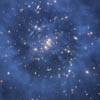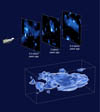News Archive
1996 |
1997 |
1998 |
1999 |
2000 |
2001 |
2002 |
2003
2004 | 2005 | 2006 | 2007 | 2008 | 2009 | 2010 | 2011
2012 | 2013 | 2014 | 2015
2004 | 2005 | 2006 | 2007 | 2008 | 2009 | 2010 | 2011
2012 | 2013 | 2014 | 2015
![]()
Welcome to our archive of past news articles.
You will find previous articles listed below
from most the recent back to our first articles in 1996.
2007
 |
'Death Star' Galaxy Black Hole Fires at Neighboring Galaxy [19 December 2007] - A powerful jet from a super massive black hole is blasting a nearby galaxy, according to new findings from NASA observatories. This never-before witnessed galactic violence may have a profound effect on planets in the jet's path and trigger a burst of star formation in its destructive wake. |
 |
Massive Black Hole Smashes Record [31 October 2007] - Using two NASA satellites, astronomers have discovered the heftiest known black hole to orbit a star. The new black hole, with a mass 24 to 33 times that of our Sun, is more massive than scientists expected for a black hole that formed from a dying star. |
 |
Scientists Model a Cornucopia of Earth-sized Planets [27 September 2007] - In the Star Wars movies fictional planets are covered with forests, oceans, deserts, and volcanoes. But new models from a team of MIT, NASA, and Carnegie scientists begin to describe an even wider range of Earth-size planets that astronomers might actually be able to find in the near future. |
 |
NASA Astronomers Find Bizarre Planet-Mass Object Orbiting Neutron Star [12 September 2007] - Using NASA's Swift and Rossi X-ray Timing Explorer (RXTE) satellites, astronomers have discovered one of the most bizarre planet-mass objects ever found. |
 |
Astronomers Pioneer New Method for Probing Exotic Matter [27 August 2007] - Using European and Japanese/NASA X-ray satellites, astronomers have seen Einstein's predicted distortion of space-time around three neutron stars, and in doing so they have pioneered a groundbreaking technique for determining the properties of these ultradense objects. |
 |
Japanese and NASA Satellites Unveil New Type of Active Galaxy [30 July 2007] - An international team of astronomers using NASA's Swift satellite and the Japanese/U.S. Suzaku X-ray observatory has discovered a new class of active galactic nuclei (AGN). |
 |
NASA's Spitzer Finds Water Vapor on Hot, Alien Planet [13 July 2007] - A scorching-hot gas planet beyond our solar system is steaming up with water vapor, according to new observations from NASA's Spitzer Space Telescope. |
 |
NASA Scientists Pioneer Technique for "Weighing" Black Holes [27 June 2007] - Two astrophysicists at NASA's Goddard Space Flight Center in Greenbelt, Md., Nikolai Shaposhnikov and Lev Titarchuk, have successfully tested a new method for determining the masses of black holes. |
 |
Astronomers Find Ring of Dark Matter with Hubble Space Telescope [16 May 2007] - Astronomers using NASA's Hubble Space Telescope have discovered a ghostly ring of dark matter that formed long ago during a titanic collision between two galaxy clusters. Dark matter makes up most of the physical material in the universe's material, while ordinary matter, which makes up stars and planets, comprises only a small percentage. The ring's discovery is among the strongest evidence yet that dark matter exists. |
 |
Astronomers See Evidence of New Type of Supernova [09 May 2007] - The brightest stellar explosion ever recorded may be a long-sought new type of supernova, according to observations by NASA's Chandra X-ray Observatory and ground-based optical telescopes. This discovery indicates that violent explosions of extremely massive stars were relatively common in the early universe, and that a similar explosion may be ready to go off in our own galaxy. |
 |
New Technologies for James Webb Space Telescope Approved Early [03 May 2007] - More than a year ahead of schedule, a team of independent experts has approved all ten new technologies developed for NASA's James Webb Space Telescope. Many of the technologies are revolutionary and have never before been used on any satellite or space telescope. The early approval can reduce the risk of increased costs and schedule delays before the program is approved for further development. |
 |
NASA's Spitzer First to Crack Open Light of Far Away Worlds [05 March 2007] - NASA's Spitzer Space Telescope has captured for the first time enough light from planets outside our solar system to identify molecules in their atmospheres. The landmark achievement is a significant step toward being able to detect possible life on rocky exoplanets and comes years before astronomers had anticipated. |
 |
Scientists Find High Energy Systems Hidden in 'Gas Cocoon' [16 February 2007] - Astronomers have found a new class of objects in space: a neutron star orbiting inside a cocoon of cold gas and/or dust that hides a bloated supergiant star. In a strange twist of fate, these objects may be tremendously luminous, but the enshrouding cocoon absorbs almost all their emission, making them nearly invisible to telescopes on Earth until now. |
 |
Hubble Maps the Cosmic Web of "Clumpy" Dark Matter in 3-D [23 January 2007] - An international team of astronomers using NASA's Hubble Space Telescope has created the first three-dimensional map of the large-scale distribution of dark matter in the universe. |
1996 |
1997 |
1998 |
1999 |
2000 |
2001 |
2002 |
2003
2004 | 2005 | 2006 | 2007 | 2008 | 2009 | 2010 | 2011
2012 | 2013 | 2014 | 2015
2004 | 2005 | 2006 | 2007 | 2008 | 2009 | 2010 | 2011
2012 | 2013 | 2014 | 2015
Take Me to the News Page

